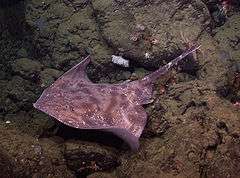Broad skate
| Broad skate | |
|---|---|
 | |
| A broad skate on the Davidson Seamount, at a depth of 1641 meters. | |
| Scientific classification | |
| Kingdom: | Animalia |
| Phylum: | Chordata |
| Class: | Chondrichthyes |
| Order: | Rajiformes |
| Family: | Rajidae |
| Genus: | Amblyraja |
| Species: | A. badia |
| Binomial name | |
| Amblyraja badia (Garman, 1899) | |
| Synonyms | |
|
Raja badia Garman, 1899 | |
The broad skate, Amblyraja badia, is a poorly known species of skate in the family Rajidae. It occurs at depths of 846 to 2,324 metres (2,776 to 7,625 ft), and has been observed via ROV by the Monterey Bay Aquarium Research Institute as deep as 3,167 metres (10,390 ft), making it the deepest-occurring skate known.[1] It is sporadically distributed in the Pacific Ocean, from the Gulf of Panama to British Columbia and the Bering Sea, to the "Tohoku Slope" off northern Honshu and the "Okhotsk Slope" off Hokkaido.[2] The species name, badia, comes from the Latin batius meaning "brown", referring to its color.[3]
The pectoral fin disc of the broad skate is wider than it is long, with sharply rounded apices. The snout is short and blunt, with several enlarged thornlets at the tip. Its underside is smooth and its dorsal surface is densely covered with prickles. There are 2-3 pairs of distinctive scapular thorns on each shoulder, usually arranged in a triangle, and a row of 24-29 median thorns along the back, flanked by a row of smaller lateral thornlets on the tail. The tail is relatively short and tapering, with two similar-sized dorsal fins and no interdorsal thorn. The very small caudal fin is placed close behind the second dorsal fin. The coloration is chocolate-brown to gray-brown above with scattered darker spots, same below except for the pelvic fin lobes and tail, which are darker. There are whitish areas on the snout, upper abdomen, nostrils, mouth, gill slits, and anal opening.[3]
Broad skates feed on cephalopods, crustaceans, and small bony fishes such as rattails. It is presumably oviparous like other skate species. Males mature from 86 to 93 centimetres (34 to 37 in) and grow to at least 95 centimetres (37 in), while females grow to at least 99 centimetres (39 in). The smallest known free-swimming specimens measured 23 centimetres (9.1 in). This species is of no commercial interest, but is occasionally taken as by-catch in deepwater trawls and traps.[3]
References
- ↑ Kuhnz, L. Elasmobranch of the Month: January 2006. Pacific Shark Research Center. Retrieved on November 15, 2008.
- ↑ Froese, Rainer and Pauly, Daniel, eds. (2007). "Amblyraja badia" in FishBase. October 2007 version.
- 1 2 3 Ebert, D.A. (2003). Sharks, Rays, and Chimaeras of California. London: University of California Press. ISBN 0-520-23484-7.
